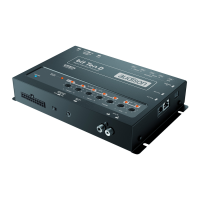What to do if settings are not stored on Audison bit Ten D?
- TTroy ParkerJul 30, 2025
If your Audison Computer Hardware settings aren't being stored, use your PC to select 'File' from the main software menu, and then choose 'Finalize to bit Ten D'.

What to do if settings are not stored on Audison bit Ten D?
If your Audison Computer Hardware settings aren't being stored, use your PC to select 'File' from the main software menu, and then choose 'Finalize to bit Ten D'.
What to do if Audison bit Ten D does not respond?
If the Audison bit Ten D does not respond, try turning it off using the DRC knob, disconnecting the Remote IN, or disconnecting the power supply cable for a few seconds. Then, save the setup as a file on your PC using 'FILE / SAVE SETUP', exit the software, turn the bit Ten D back on, relaunch the software, and load the setup file again using 'FILE / LOAD SETUP'.
| Type | Digital Signal Processor |
|---|---|
| Channels | 10 |
| Input Impedance | 10kΩ |
| Output Impedance | 100Ω |
| Bandwidth | 20Hz - 20kHz |
| Channel Separation | > 80dB |
| DSP Resolution | 24 bit |
| Crossover Frequency | 20Hz - 20kHz |
| Time Alignment | Yes |
| PC Connection | USB |
| Crossover Slopes | 12dB/Octave, 24dB/Octave |
| Equalizer | 31 bands |
| Time Alignment Step | 0.02 ms |
| THD + N | <0.005% |
Lists all items included in the bit Ten D product package.
Details the steps and mounting dimensions for installing the Digital Remote Control (DRC).
Explains the pinout and function of the 20-pin multipolar connector for inputs, power, and controls.
Describes the 4 Hi-Level speaker inputs for connecting amplified signal cables from the main analog source.
Details the power supply connections and remote control input/output terminals for the bit Ten D.
Explains how to adjust input signal sensitivity using the IN Level knobs for optimal signal-to-noise ratio.
Outlines the various methods for turning the bit Ten D processor on and off, including DRC, KEY MEM, and AUTO TURN ON.
Shows how to connect speakers in hi-level stereo and multi-channel configurations to the bit Ten D.
Explains how to connect a digital optical fiber cable and the limitations of accepted digital input signals.
Illustrates how to connect the bit Ten D's digital outputs to amplifiers using AD Link and AC Link connections.
Details connecting to amplifiers with AD Link/AC Link or pre-input using RCA connections.
Provides a step-by-step guide to calibrate the input sensitivity of the master front and rear channels.
Explains the process of analyzing and performing source de-equalization to remove factory equalization.
Explains the process for calibrating the input sensitivities for the PHONE and AUX IN inputs.
Step-by-step guide for installing the bit Ten D PC software, including navigating the setup wizard.
Details how to select master inputs and outputs in TARGET mode for system configuration.
Guides the user on setting the source parameters, including tone controls, balance, fader, and volume for calibration.
Describes how to select speakers within the software for system configuration and channel assignment.
Details the allocation of AD Link and PRE OUT outputs to specific channels for amplifier connections.
Details the steps for executing the de-equalization procedure on the audio source.
Provides methods for calibrating amplifier sensitivity to achieve optimal acoustic results and minimize noise.
Explains the OFFLINE mode for familiarizing with software functions without PC interaction.
Describes the functions available in the 'File' menu, such as loading and saving setups.
Details the process of finalizing selected parameters into the bit Ten D's internal memory for standalone operation.
Guides the setup of the system and configures the bit Ten D according to specific requirements.
Displays names assigned to output channels and allows management of each channel, including muting and editing.
Describes the Xover L/R Link feature, which applies filter settings adjustments to both channels simultaneously.
Explains the filter slope options (dB/Oct) and how they apply to different filter types and modes.
Covers setting speaker distances, default delay calculation, and manual fine-tuning for phase alignment.
Details the five specific functions of the graphic equalizer for adjustments: Select ALL, Flat, EQ L/R Link, EQ Off, and Select.
Explains how to use sliders, Mute, Link, Solo, Volume, and Sub Volume controls to adjust output levels.
Details features for loading and saving system configurations, including all presets, current presets, and copying presets.
Addresses issues related to synchronizing the bit Ten D with a PC, including connection and response problems.
Details the steps for downloading and installing firmware updates using the bit Ten D PC software.
Describes how to use the DRC knob and buttons to control volume, balance, fader, and subwoofer volume.
Details the functions accessible via the SEL button, including DSP Memory, DSP Settings, and Brightness adjustment.
Describes the DRC cable extension kit, its purpose, and specifications for extending cable length.